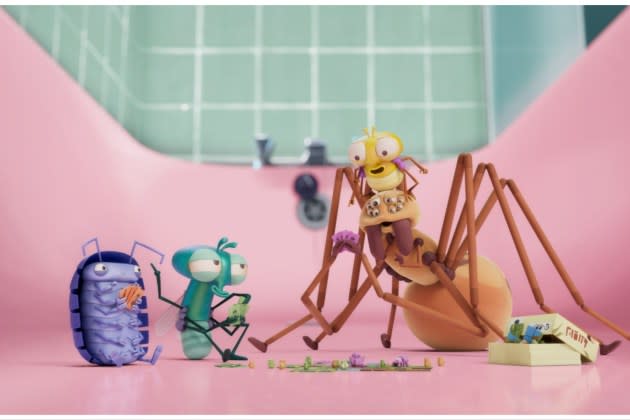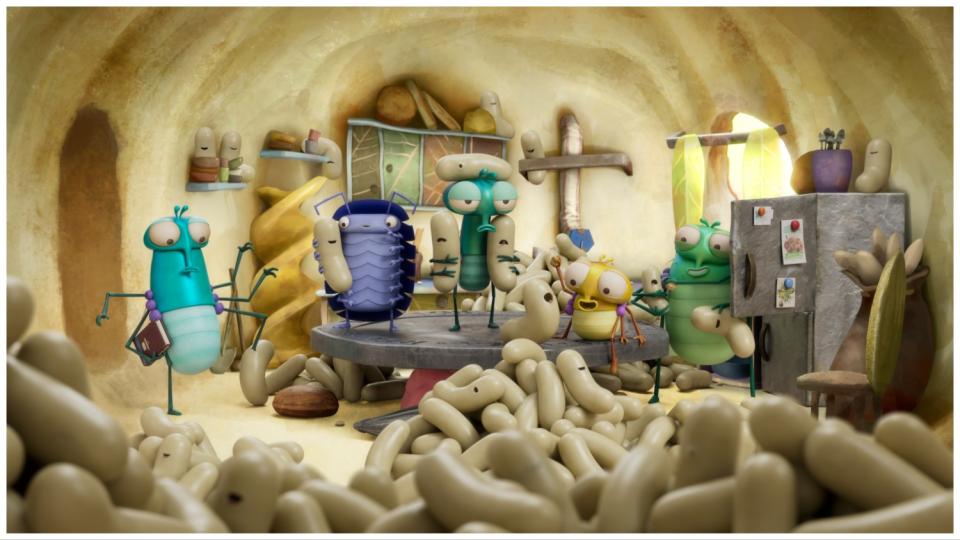How Aardman’s First CGI Series ‘Lloyd of the Flies’ Evolved: ‘Sometimes We Went the Silly Route, Just to Make It Fun, and Added Farts’
- Oops!Something went wrong.Please try again later.
- Oops!Something went wrong.Please try again later.
- Oops!Something went wrong.Please try again later.
- Oops!Something went wrong.Please try again later.
- Oops!Something went wrong.Please try again later.
- Oops!Something went wrong.Please try again later.

Following in the footsteps of Aardman Animations legends Peter Lord, David Sproxton and Nick Park, a new wave of creators are driving the company forward. While its celebrated franchises, such as Wallace and Gromit, Shaun the Sheep and Chicken Run are still much loved, and it has four Oscars wins with nine further nominations under its belt, Aardman is also focused on nurturing new talent, such as the creators of Oscar nominated short film “Robin Robin,” and series, such as “Lloyd of the Flies” and “The Very Small Creatures.”
Speaking to Variety from Aardman’s headquarters on Spike Island, Bristol, in the West of England, two of the creative minds behind “Lloyd of the Flies,” Aardman’s first CGI series, explain how the show evolved. In other articles, Variety speaks to Dan Ojari and Mikey Please, the creators of “Robin Robin,” and Lucy Izzard, the creator of “The Very Small Creatures.”
More from Variety
Jonathan Ross to Host U.K. Academy Awards Coverage as ITV Launch Oscar-Nominated Movies FAST Channel
“Lloyd of the Flies,” a comedy series for 7-11 year olds, premiered on CITV, the kids’ platform run by U.K. commercial broadcaster ITV, in September 2022.

The series follows the adventures of Lloyd B Fly, a housefly and the middle child of 451. Lloyd lives with his parents, his little sister PB and their 224 maggot siblings inside a compost bin they call home. In the series, Lloyd and PB are usually accompanied by Lloyd’s best friend, Abacus Woodlouse, and eccentric tag-along, Cornea Butterfly.
“Lloyd of the Flies” is created and directed by Matthew Walker. He is joined by co-director and voice director Jane Davies. The voice cast is led by Tom Rosenthal (“Friday Night Dinner,” “Plebs”) as Lloyd. Abacus is voiced by Alex Lawther (“The End of the F***ing World,” “Black Mirror”), while Lauren Patel (“Everybody’s Talking About Jamie”) is PB. The writing team comprised two head writers and a core team of about five writers.
Since “Lloyd” wrapped at the end of 2022, Walker has created and written a spinoff called “Adventures of ArachnoFly,” which plays on YouTube. Davies is the director. The 2D series is based on the superhero comic that Lloyd reads in “Lloyd of the Flies.” Walker describes the show as “very silly and irreverent.”
The idea for “Lloyd of the Flies” was hatched in 2015 when Walker responded to an internal call out for ideas to create new IP, primarily for a children’s series. “I didn’t have an idea at the time, but I wanted to pitch something. So, I pretty much came up with the title first and worked backwards from that,” he says. “So the initial pitch was just a few paragraphs. I had the main characters, which haven’t really changed, and a very loose idea of the world.”
Aardman went with that and gave him development money to work up his idea – in amongst other projects – until the show received a greenlight in 2020. During the final year of development, the show moved from 2D to 3D. “We built ‘Lloyd’ in CG and really liked how it looked, and that’s when we decided to change the whole look of the show,” Walker says.

CITV was the first on board, followed by German broadcaster ZDF. The show also received financial support during its development phase from the U.K. government-funded Young Audience Content Fund, which is managed by the British Film Institute. Last year, Tubi acquired the U.S. and Canadian rights to the series, and it premiered on the streamer in August.
Although making the show age appropriate was a consideration, it was not the most important part of the equation. “With ‘Lloyd,’ we knew roughly what age range we were targeting, but ultimately, we were just trying to make a series that we found funny, that we enjoyed. So, it was just making sure it was still suitable for a young audience,” Walker says. “But we weren’t tailoring it to reach a particular age group. The age group we targeted came about because, as we developed the series, it was like, ‘Well, what age group do we think would like this?,’ and 7 to 11s felt like the right age.”
Davies adds: “Also it’s good to make it good for co-watching because I have kids and the amount of children’s TV that you watch with your kids, I just really wanted to watch something that I would enjoy as well.”

Walker continues: “I think it can be easy to underestimate kids, and even if there are jokes or themes that go over their heads, they can still enjoy the rest of the episode, and the older audience will be able to appreciate the jokes that the kids might not get. It’s what Pixar does so well, and I guess that’s the ballpark we’re trying to play in.”
The show evolved as the early scripts were being written, and again once the show went into production, with additional locations and characters being added.
“As we were writing the scripts, and making the episodes, we were discovering the characters that really worked, and also what the actors brought to the characters that influenced the later scripts,” Walker says. “And when we found characters that really, really popped we’d start to focus on them in later episodes. There are a lot of characters that we thought would appear in just one episode, but then we wanted to keep returning to that character. So, the cast of characters grew in a nice, organic way over the course of making the series.”
“And also, the locations. At the beginning, we had five core locations that we knew we could go to, and we then gradually introduced more locations. It was quite an organic process as we went along, as the production fed back into the scripts, and we saw what worked.”
Davies adds Walker had “written such a rich world” that it populated naturally.
Walker says that his approach to this world evolved as they entered production. “Initially I’d written quite a detailed writer’s bible, with lots of rules of the world and stuff, and as we went, I realized this doesn’t work,” he says. He became more willing to say some of his “rules” could be ignored. “I went too granular with the detail initially, and then realized that it worked better if we were looser with the rules and played around more.”
Emotion plays a role in many of the episodes, such as when Lloyd and Abacus think they are going to be parting ways for good and must wrestle with feelings of loss. But these emotions “came quite naturally,” Walker says. “It usually came from the characters.” In this case, the friendship between the two that had been built up over the preceding episodes and made the sense of loss feel quite natural when it was threatened. “I always want there to be emotion in the series, but try to avoid it becoming cheesy,” he adds. “Sometimes, Lloyd would learn a lesson, but we’d never force it. Sometimes he wouldn’t learn anything or learn the wrong thing. We would usually go with what was funniest and what was most true to the characters.”
Davies adds: “And sometimes we tried to go the silly route, just to make it fun, and added farts.”
Best of Variety
'House of the Dragon': Every Character and What You Need to Know About the 'Game of Thrones' Prequel
Sign up for Variety’s Newsletter. For the latest news, follow us on Facebook, Twitter, and Instagram.

